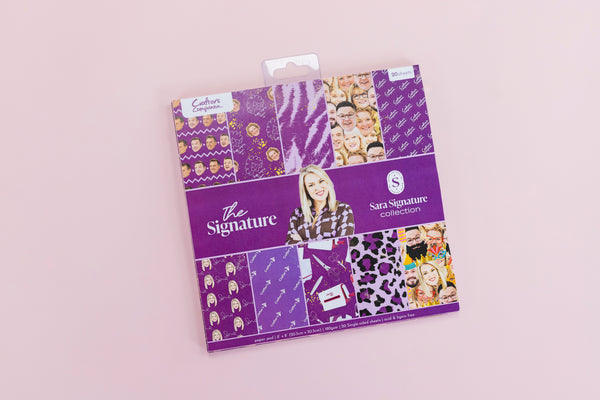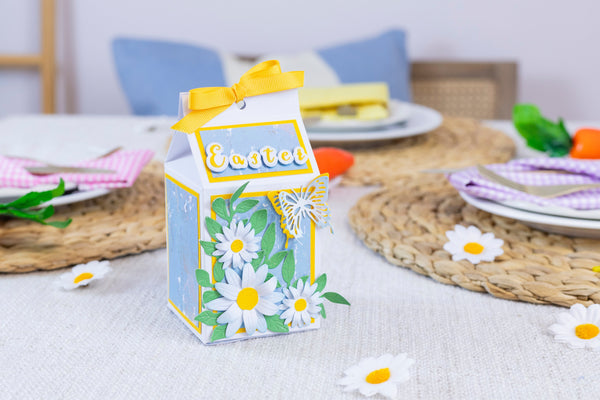The beginner's guide to die-cutting
- Read time: 6 minutes
- Written by: Crafters
You all know how much we love die-cutting, here at Crafter's Companion. It's one of our favourite ways to embellish our papercraft projects, especially because there are so many different die designs available. It's a technique that can be used for absolutely any occasion, any kind of papercraft project, like cardmaking, scrapbooking and home decor, and with a huge variety of materials.
While we've done a couple of more focused beginner's guides, like the beginner's guide to Edge'able dies and the beginner's guide to multi media die-cutting for our needlecraft friends, so we thought it would be great to do a more papercraft-focused die-cutting guide. Even if you're a bit of a pro in die-cutting, it's definitely worth looking through this post to see if you can learn anything new!

What is die-cutting?
Die-cutting is the process of using a machine that applies pressure to cut out delicate shapes, achieving effects that usually can’t be achieved with scissors or craft knives. This is done by using dies – a shaped metal with a cutting edge, which is pressed into a material through the die-cutting machine. You’re able to repeatedly create the shame shape with the exact same dimensions, saving you time and giving you a professional finish.
What materials can you cut with dies?
The most obvious materials are paper and card, and these are what you would usually find on the front of most papercraft projects. But there are actually a whole host of other materials that you can cut, including:
Foil – perfect for adding a metallic effect to your creations
Vellum – this translucent paper product will add a soft and elegant look
Chipboard – by adding chipboard, you’ll give your project more stability
Vinyl – this would make brilliant stickers
Cork – add instant texture to projects with die-cut cork
Foam – perfect for multi media projects or for adding underneath paper die-cuts for height

What else can you do with dies?
Even though dies are mainly designed to cut shapes out from your chosen material, you can also use some dies for embossing! This is the technique of creating a raised impression in your material instead of cutting all the way through and this can achieved by using an embossing mat in your die-cutting sandwich.
An embossing mat provides much less pressure on the die and material, and gives it a softer base the press against, preventing the die from cutting through.
What to do if you can’t remove the die-cuts
It can be very frustrating if you’ve just cut out the tiniest and most dainty shape in the world, only for it to get stuck against the die. Our first piece of advice is not to pull it because it would be a total disaster if it ripped! Don’t panic and don’t do anything too hasty.
Our second piece of advice would be to pick up a Die Brush Tool and Foam Pad. With this little set, you can easily loosen any delicate die-cut pieces from dies without damaging them. All you need to do is place your die cut side down on the foam pad and roll the bristles of the tool back and forth over the die. This will release any pieces that may be lodged, so it’s an essential item for any die cutter.

What is a die-cutting sandwich?
When a crafter refers to a 'sandwich', they're talking about the combination of die-cutting plates that are put together and rolled through the machine. There are different combinations for different effects and level of detail on a die, so make sure you check out the sandwich menu - our guide to die-cutting and embossing sandwiches.
What are the different die-cutting plates?
- Clear cutting plates – essentially, these are the slices of bread for your sandwich. You need two clear cutting plates, one for the top and one for the bottom, and these protect the contents of your sandwich and provide a surface for the die-cutting machine to press together.
- Metal cutting plates – this is a type of shim that’s perfect for more intricate dies. Imagine a pair of scissors and the two metal blades coming together for a crisp cut – that’s how this shim works with metal dies! You’ll see a much more defined cut with this plate included in your sandwich.
- Plastic shims – this is a durable plate that adds an extra layer to your die-cutting sandwich, creating a better fit in the machine and a level surface.
- Magnetic shims – like the plastic shim, this shim adds an extra layer into your sandwich, but as it’s magnetic, it also helps to keep your dies in place while they’re rolled through the machine.
- Rubber embossing mats – this nifty mat allows you to use dies as embossing tools as it creates a softer impact. Instead of applying enough pressure for the die to cut through the card or paper, it reduces the pressure to result in an embossed image or pattern.
With the plates and shims, it's vital to remember to flip and rotate them after each use. This will help to prevent bowing, but it's always good to have some extra in your stash, just in case.

Is it normal to hear a cracking sound when you roll a sandwich through the machine?
Yes, this is completely normal! It might sound like your die-cutting plates are snapping or the machine is breaking, but we promise, everything will be perfectly fine. You definitely haven't done anything wrong if this happens!
How to care for your die-cutting machine
- If you’re running a cutting plate through your machine more than once, you’ll need to flip the plate each time to prevent bowing.
- Always use the correct sandwich or plate configuration that is recommended by the machine manufacturer, otherwise you could cause damage to your machine.
- Never force your plates through!
- Try to die cut away from the centre of your cutting plates, as this is where the weakest amount of pressure is.
- Make sure you clean your machine periodically. Removing small bits and dirt will help the performance of your die-cutting machine.

We hope that this guide has answered any of your questions about die-cutting, but if not, ask us on Facebook UK, Facebook USA, Twitter, Instagram UK, Instagram US, Pinterest UK or Pinterest US using the hashtag #crafterscompanion. Be sure to show us your die-cutting projects too!














